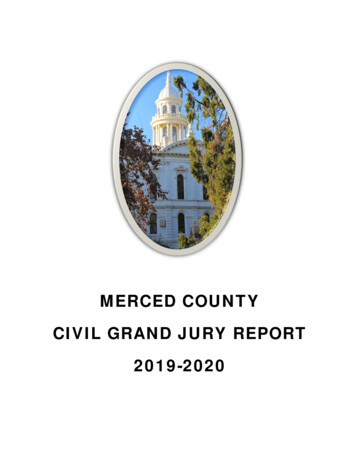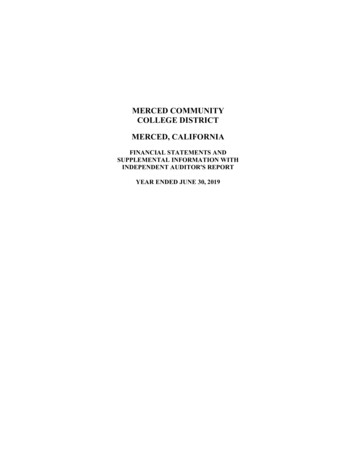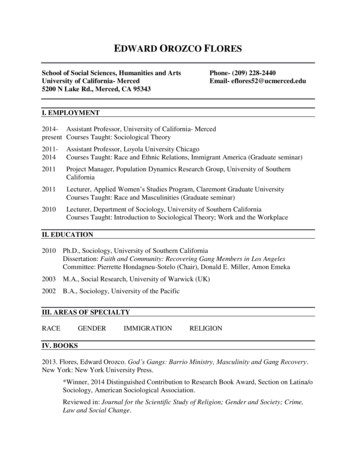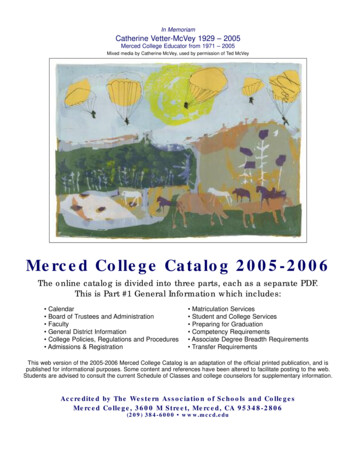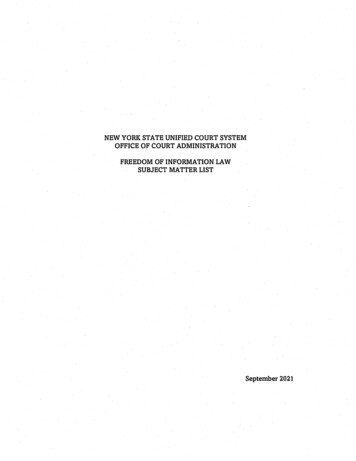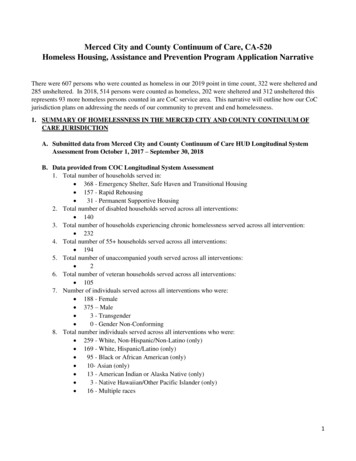
Transcription
Merced City and County Continuum of Care, CA-520Homeless Housing, Assistance and Prevention Program Application NarrativeThere were 607 persons who were counted as homeless in our 2019 point in time count, 322 were sheltered and285 unsheltered. In 2018, 514 persons were counted as homeless, 202 were sheltered and 312 unsheltered thisrepresents 93 more homeless persons counted in are CoC service area. This narrative will outline how our CoCjurisdiction plans on addressing the needs of our community to prevent and end homelessness.1. SUMMARY OF HOMELESSNESS IN THE MERCED CITY AND COUNTY CONTINUUM OFCARE JURISDICTIONA. Submitted data from Merced City and County Continuum of Care HUD Longitudinal SystemAssessment from October 1, 2017 – September 30, 2018B. Data provided from COC Longitudinal System Assessment1. Total number of households served in: 368 - Emergency Shelter, Safe Haven and Transitional Housing 157 - Rapid Rehousing 31 - Permanent Supportive Housing2. Total number of disabled households served across all interventions: 1403. Total number of households experiencing chronic homelessness served across all intervention: 2324. Total number of 55 households served across all interventions: 1945. Total number of unaccompanied youth served across all interventions: 26. Total number of veteran households served across all interventions: 1057. Number of individuals served across all interventions who were: 188 - Female 375 – Male 3 - Transgender 0 - Gender Non-Conforming8. Total number individuals served across all interventions who were: 259 - White, Non-Hispanic/Non-Latino (only) 169 - White, Hispanic/Latino (only) 95 - Black or African American (only) 10- Asian (only) 13 - American Indian or Alaska Native (only) 3 - Native Hawaiian/Other Pacific Islander (only) 16 - Multiple races1
2. DEMONSTRATION OF REGIONAL COORDINATIONA. Coordinated Entry System (CES) Information1. Description of CES functionalitya. Policy Oversight Entity: CoC BoardThe CoC Board is the Merced CES policy oversight entity. Policy-level oversight ensures that thegoals and standards for coordinated entry developed during the CoC’s CE planning process are beingmet. The CoC includes relevant mainstream service providers in coordinating services and assistanceand conducting activities related to continual process improvement. The core responsibilities of thepolicy oversight entity are to establish and oversee the policies that allow the coordinated entryprocess to operate in accordance with the planning group’s decisions related to coordinated entry’score elements: Access, Assessment, Prioritization, and Referral. This builds off the decisions madein the planning process in four core areas: Clearly describe and document participation expectations for participation in CE, including:o Use of appropriate assessment toolso Participation in case conferencing or other coordination mechanisms. Case conferencesinclude CE staff meetings to discuss cases, resolve barriers to housing, and make decisionsabout priority, eligibility, termination, and appealo Use of CE to fill project vacancies or openingso Addressing the safety needs of survivors of domestic violenceo Incentives or penalties associated with meeting or failing to meet those expectations Determine local data collection and data quality expectations by:o Establishing written procedures for how each data collection expectation will be met andwhich entity, project, or project type is expected to collect the datao Including the HMIS lead in planning for management of datao Aligning expectations with evaluation planning Define data sharing protocols by:o Ensuring adequate privacy protections of all participant information, including written P&Pfor obtaining participant consent to share and store participant information for purposes ofassessing and referring participants through the CE process Select a data system for CE, which is HMIS.o The CoC is responsible for the following for participating agencies: Ongoing staff training on the operating policies and procedures Data collection and analysis supportManagement Entity: Collaborative Applicant and HMIS LeadTwo roles are designated as the management staff for CE. (1) is the Collaborative Applicant as thecoordinator who works for the management entity, the CoC Board, to lead the coordinated entryday-to-day process. (2) is the HMIS lead as a system administrator who oversees data entry for theHMIS. The CoC board ensures that the management entity has the formal authority to compel allproviders included in the CE to meet the expectations, standards, and responsibilities set for themby the CoC. Management entity responsibilities include: Establishing day-to-day management structureso Following the P&P outlined in this guide to implement the CESo Administering the grievance and appeal process for families and individuals in situationsthat are not resolved at the provider level, outlined in our CES policy & procedure guide.2
oo Supporting existing or building new collaborations with mainstream resourcesDocumenting costs of operating CE and identifying eligible funding opportunities for thosecostso Monitoring CE requirements from fundersEstablishing a clear, accessible communications plan, outlined in the P & P guide.o Identify points of contact for CE questions and information at each agencyo Dedicated email addresses and procedures for communicating about participantso A website for forms and newso Methods for development and distribution of waiting listso Procedures for communication about enrollment vacancies and referrals of selectedparticipantsPromoting standardized screening and assessment processeso Developing forms for each step of the CE process which follow the sequence and decisionslogic of the CE process and stages to make data collection efficiento Together with each agency participating in CE, review the CE forms for clarity and ease ofuse.o Maintain up-to-date versions of forms and document any changes, noting the date of change,reason for the change, and the entity requesting or making the change.Developing and delivering trainingo Provide training protocols and at least one annual training opportunity to participating staffat organizations that serve as access points or otherwise conduct assessments. The purposeof the training is to provide access to materials that clearly describe the methods by whichassessments are to be conducted with fidelity to the CoC’s CE process, including its writtenpolicies and any variations.o Update and distribute training protocols at least annually, which include the requirementsfor prioritization and the criteria for uniform decision-making and referrals.Conducting monitoring at both system and project levelo Monitor participant outcomes through system performance measures, including review ofParticipant status and outcome reports from HMIS will be reviewed monthly or quarterlyo Monitor participating providers for their program’s fidelity to the CE P&PAdditional tasks assigned to the Management Entity include: Recruit, train, and onboard participating partner agencies into the CES. Make ongoing site visits and implement quality assurance strategies for CES process. Maintain information about all providers’ available housing and service programs, clienteligibility, and housing inventory. All information will be updated at least annually. Assure data and application quality, and when appropriate work with providers to improvesubmission processes. Manage the By-Name List(s) and housing referrals, in accordance with the CoC WrittenStandards and CES Policies & Procedures. Facilitate case conferencing processes with the Case Conferencing Committee, veterans group,or other groups as needed with the goal of assuring clients are referred to appropriateinterventions. Create and implement a strong marketing strategy for the CES that targets providers whoserve homeless individuals and families, and educates the broader community about how toaccess the CES. Convene various CoC groups to keep stakeholders updated and aware of changes to the CES.3
Lead efforts for evaluation and continuous quality improvement which include bothprovider feedback and client input, including outcome reports.Provide ongoing updates to CoC Board and relevant committees of the CoC.In cases where no Access Point can be identified, connect client to the CoCAdministrator for direction in completion of the CES application.Evaluation Entity: CoC BoardThe CoC Board is responsible for the evaluation process, which is the use of participant andprovider data to measure the functioning of the CoC. Regular and ongoing evaluation of the CEsystem will be conducted to ensure that improvement opportunities are identified, that results areshared and understood, and that the CE system is held accountable.b. CES Assessment ProcessThe CoC’s CE process will provide a standardized assessment process to all CE participants,ensuring uniform decision-making and coordination of care for persons experiencing a housingcrisis. All persons served by CE will be assessed using the VI-SPDAT. All access points must usethis tool to ensure that all persons served are assessed in a consistent manner, using the sameprocess. The VI-SPDAT documents a set of participant conditions, attributes, need level, andvulnerability, allowing the access point and/or assessment staff to identify a service strategy to theHMIS Lead who manages the CoC’s prioritization list.Merced City and County CoC uses the Vulnerability Index – Service Prioritization DecisionAssistance Tool (VI- SPDAT, e.g. the assessment survey) created by OrgCode Consulting, Inc. andCommunity Solutions as the standard triage assessment tool. This assessment tool will be used forall homeless individuals and households in Merced City and County.The CES listing prioritizes individuals with the greatest vulnerabilities based on VI-SPDATassessments scores. The CES committee works to ensure that people experiencing homelessnessreceive the right housing interventions by matching them to available resources as quickly aspossible by programs removing barriers in order to access housing. All funded programs mustalign and comply with core components of Housing First. Individuals experiencing homelessnessshall have voluntary services tailored to meet their current needs by removing all barriers to housingand giving them a choice in where to live and whether to participate in available programs or acceptadditional services. Referrals to housing and services are person centered and based on theindividual needs in order to connected them with permanent housing or permanent supportivehousing. All housing providers are mandated by our CoC Charter to adhere to Housing FirstPractices and follow the Core components in regards to housing homeless individuals.All service providers and/ or vendors that receive funding as a sub recipient must provide all eligibleactivities in a manner consistent with the Housing First practices described in California Code ofRegulations, Title 25, Section 8409, subdivision (b)(1)-(6). Sub recipient allocated funds foreligible activities that provide permanent housing (as defined in Section 50490(k)) shall incorporatethe core components of Housing First, as provided in Section 8255, subdivision (b) of the Welfareand Institutions Code. Housing First is an evidence- based model that uses housing as a tool, ratherthan a reward, for recovery and that centers on providing or connecting homeless people topermanent housing as quickly as possible. Under the Housing First model, services offered are asneeded and requested on a voluntary basis, and do not make housing contingent on participation inservices.4
Phases of AssessmentAll projects participating in CE will follow the assessment and triage protocols of the CE system.The assessment process will progressively collect only enough participant information toprioritize and refer participants to available CoC housing and support services.The CoC has adopted the following phased approach to engage and appropriately serve personsseeking assistance through the CE system:1. Initial Triage (Immediately): This first phase will focus on identifying the immediate housingcrisis, and clarifying that the CoC crisis response system is the appropriate system to addressthe potential participant’s immediate needs.2. Diversion or Prevention Screening (Immediately): The second phase of assessment can alsohappen immediately upon engaging with a participant. During this phase, CE staff willexamine existing CoC and participant resources and options that could be used to avoid theparticipant entering the homeless system of care.3. Crisis Services Intake (Immediately): The third phase should also happen immediately, as itis intended to collect all information necessary to enroll the participant in a crisis responseproject such as emergency shelter or other homeless assistance project.4. Initial Assessment (Within 3 business days): During the fourth phase, assessors will collectinformation to identify a participant’s housing and service needs with the intent to resolvethat participant’s immediate housing crisis.5. Comprehensive Assessment (Within 5 business days after initial assessment): In the fifthphase, the assessor will seek information necessary to refine, clarify, and verify aparticipant’s housing and homeless history, barriers, goals, and preferences. Assessmentinformation supports the evaluation of the participant’s vulnerability and prioritization forassistance.6. Next Step / Move On Assessment (Ongoing): The final phase will collect informationrevealed or known after an Initial Assessment is conducted when that new information mightsuggest a revised referral strategy. Or it will re-evaluate participants who have been stablyhoused for some time and who might be ready for less-intensive housing and servicestrategies.Assessment ScreeningThe CE process may collect and document participants’ membership in Civil Rights protectedclasses but will not consider membership in a protected class as justification for restricting,limiting, or steering participants to particular referral optionsAssessor TrainingThe CoC is committed to ensuring that all staff who assist with CE operations receive sufficienttraining to implement the CE system in a manner consistent with the vision and framework ofCE, as well as in accordance with the policies and procedures of its CE system.The HMIS intake and assessment survey can only be conducted by staff or volunteers who havesuccessfully completed training and been authorized by Community Action Agency (CAA) orHuman Services Agency (HSA) HMIS. All intake and assessment surveys will be conductedusing the approved HMIS Intake Forms and the Assessment Survey tool for the intendedindividual or family.After initial training, the CoC will provide at least annual training for persons who will manageaccess point processes and conduct assessments for CE. Training will be offered at no cost to theagency or staff, and will be delivered by an experienced and professional trainer who is identifiedby the CoC. The purpose of the training is to provide all staff who administer intakes and5
assessments with access to materials that clearly describe the methods by which assessments areto be conducted with adherence to the CoC’s coordinated entry written policies and procedures.Topics for training will include the following: Review of CoC’s written CE policies and procedures, including variations adopted forspecific subpopulations; Requirements for use of assessment information to determine prioritization; Intensive training on the use of the CE assessment tool; and Criteria for uniform decision-making and referrals.In addition, all assessment staff must be trained at least once regarding: How to conduct a trauma-informed assessment of participants, with the goal of offeringspecial consideration to survivors of domestic violence and/or sexual assault to help reducethe risk of re-traumatization. Safety planning and other next-step procedures to be followed in the event that safety issuesare identified in the process of conducting an assessment.All staff administering assessments use culturally and linguistically competent practices inorder to reduce barriers for underserved populations, including but not limited to immigrantsand refugees, youth, individuals with disabilities, and LGBTQ individuals. The CoC shallfurther these practices by: Incorporating cultural and linguistic competency training and person-centered approachesinto the required annual training protocols for participating projects and staff members; Using culturally and linguistically competent questions for all persons that reduce cultural orlinguistic barriers to housing and services; and Providing staff access to and training in the procedures for obtaining interpretation andaccessibility services.CAA HMIS Systems Administrator will monitor the quality and consistencies of intake andassessments entered into HMIS and provide feedback, training, and adjustments topolicies and procedures as necessary to address issues that may arise. Additionally,CAA HMIS may revoke the right of any individual user or agency to participate inHMIS and/or coordinated entry if the individual or agency violates user agreements orpolicies and procedures.Participant AutonomyIt is crucial that persons served by the CoC’s CE system have the autonomy to identify whetherthey are uncomfortable or unable to answer any questions during the assessment process, or torefuse a referral that has been made to them. In both instances, the refusal of the participant torespond to assessment questions or to accept a referral shall not adversely affect his or herposition on the CE’s prioritization list.The CoC will not deny services to any participant based on that participant’s refusal to allowtheir data to be stored or shared unless a Federal statute requires collection, use, storage, andreporting of a participant’s personally identifiable information as a condition of programparticipation. All CoC coordinated entry participants are free to decide what information theyprovide during the assessment process, to refuse to answer assessment questions, and to refusehousing and service options without retribution or limiting their access to other forms ofassistance.6
Note that some funders require collection and documentation of a participant’s disability or othercharacteristics or attributes as a condition for determining eligibility. Participants who choose notto provide information in these instances could be limiting potential referral options.If participants reject options, the CoC must describe the conditions for participants to maintaintheir place in CE prioritization lists. Programs may require participants to provide certain piecesof information to determine program eligibility only when the applicable program regulationrequires the information in order to establish or document eligibility.c. ReferralNotification of VacanciesAll CE participating providers will enroll new participants only from the CoC’s CE referralprocess. To facilitate prompt referrals and to reduce vacancy rates, participating providers mustnotify the Collaborative Applicant of any known and anticipated upcoming vacancies.When a TH, RRH, or PSH vacancy occurs or is expected to occur in the immediate future, theprovider agency with the vacancy must alert the CE Coordinator via email within 1 business daysof the vacancy. The notification must include specific details of the vacancy, including the projectname, unit size, location, and any funder-defined eligibility requirements.The Collaborative Applicant will provide vacancy information to the CE Governing Committee,which will work to identify a prioritized household to fill the vacancy during the next regularlyscheduled housing referral coordination meeting. The Collaborative Applicant will use the byname list to identify the highest prioritized and eligible household to fill the vacancy and refer thehousehold to the provider with the vacancy.All participating housing providers will enter their program inventory and eligibility criteria inHMIS. Program staff will work with the HMIS system administrator and CoC CES Administratorto make sure program information stays up to date. Additional eligibility criteria will be used topre-screen individuals and households on the CES Administrator for basic eligibilityParticipant-Declined ReferralsOne of the guiding principles of CE is participant choice. This principle must be evidentthroughout the CE process, including the referral phase. Participants in CE are allowed to rejectservice strategies and housing options offered to them, without repercussion.Individuals and families will be given information about the programs available to them andprovided choices whenever feasible based on assessment information, vulnerability and needscores, preliminary eligibility pre-determinations, and available resources. Of the optionsavailable, participants will be afforded their choice of which project to be referred to. If anindividual or family declines a referral to a housing program, they remain on the prioritization listuntil the next housing opportunity is available.Provider-Declined ReferralsThere may be instances when agencies decide not to accept a referral from the CE system. Whena provider agency declines to accept a referred prioritized household into its project, the agencymust notify the Collaborative Applicant of the denial and the reason for the denial. Refusals byprojects are acceptable only in certain situations, including these: The person does not meet the project’s eligibility criteria. The person would be a danger to self or others if allowed to stay at this particular project.7
The services available through the project are not sufficient to address the intensity and scopeof participant need.The project is at capacity and is not available to accept referrals at this time.Other justifications as specified by the “referred to” project.The agency must communicate the refusal to the Collaborative Applicant within 2 businessdays of making the refusal. The agency must notify the Collaborative Applicant why thereferral was rejected, how the referred participant was informed, what alternative resourceswere made available to the participant, and whether the project staff foresee additional,similar refusals occurring in the future. This information will then be shared by theCollaborative Applicant with the CE Governing Committee, which will discuss and decide onthe most appropriate next steps for both the project and the participant.2. Promotion of utilization of CESa. Affirmative Marketing & OutreachAll persons participating in any aspect of CE such as access, assessment, prioritization, orreferral shall be afforded equal access to CE services and resources without regard to a person’sactual or perceived membership in a federally protected class such as race, color, national origin,religion, sex, age, familial status, or disability. Additionally, all people in different populationsand subpopulations in the CoC’s geographic area, including people experiencing chronichomelessness, veterans, families with children, youth, and survivors of domestic violence, shallhave fair and equal access to the coordinated entry process.Each project participating in CE is required to post or otherwise make publicly available a notice(provided by the CoC) that describes coordinated entry. This notice should be posted in theagency waiting areas, as well as any areas where participants may congregate or receive services(e.g., dining hall). All staff at each agency are required to know which personnel within theiragency can discuss and explain CE to a participant who seeks more information.The CoC will affirmatively market housing and supportive services to eligible persons in theCoC’s geographic area who are least likely to apply in the absence of special outreach,including the following sub-populations: people experiencing chronic homelessness, veterans,families with children, youth, and survivors of domestic violence. Coordinated entry outreachwill be designed to ensure the coordinated access process is available to all eligible personsregardless of race, color, national origin, religion, sex, age, familial status, disability, actualor perceived sexual orientation, gender identity, or marital status. Coordinated entry outreachand any marketing materials will clearly convey that access points are accessible to all subpopulations.Good faith efforts at conducting an affirmative marketing strategy shall include the following:1. Advertising in locations or media that are used and viewed or listened to by those identifiedas least likely to enter CoC services and housing;2. Marketing CoC services and housing to specific community, religious, supportorganizations or other groups frequented by those least likely to enter CoC services andhousing:3. Developing a brochure or handout that describes CES processes to be used by personsexperiencing a housing crisis to locate, identify, and access CES services;4. Insuring that the CES management staff and operators of CES access points have readand understood the Fair Housing Act, and the purpose and objectives of the CES AMS.Outreach will be conducted by existing outreach teams and programs in the communitythat act as coordinated entry access points, including outreach resources that specificallytarget people experiencing chronic homelessness, veterans, families with children, youth,LGBTQ youth, and survivors of domestic violence and human trafficking. Culturally8
competent outreach resources with strong existing ties to the community’s most vulnerablepopulations will serve as coordinated entry access points to ensure that all subpopulationsaccess coordinated entry. Outreach will be available in the following languages to meetthe needs of minority, ethnic, and groups with Limited English Proficiency (LEP):Spanish and Hmong Assessmentsb. Complaint and Appeal ProcessesThe CoC is committed to ensuring that no information is used to discriminate or prioritizehouseholds for housing and services on a protected basis such as race, color, religion, nationalorigin, sex, age, familial status, disability, actual or perceived sexual orientation, gender identify,or marital status.The CE participant information packet must include a form that details who the point of contact isfor filing and addressing any nondiscrimination complaints, which can be filed by participants ifthey believe the nondiscrimination policy has been violated in their case during the CE process.Additionally, this form will describe and provide contact information on how to access the appealprocess if they are not satisfied with or have any questions regarding how their complaints arehandled. This form must be reviewed at the access point by CE staff, and must be signed by eachparticipant.c. Non-discrimination PolicyThe CE system must adhere to all jurisdictionally relevant civil rights and fair housing laws andregulations. The CoC has designated the CE Governing Committee as the entity responsible formonitoring agencies on compliance with all CE requirements, including adherence to civil rightsand fair housing laws and regulations. Failure to comply with these laws and regulations willresult in a monitoring finding on the project, which may affect its position in the local CoC ratingand ranking process. Fair Housing Act - prohibits discriminatory housing practices based on race, color, religion,sex, national origin, disability, or familial status. Section 504 of the Rehabilitation Act - prohibits discrimination on the basis of disability underany program or activity receiving federal financial assistance. Title VI of the Civil Rights Act - prohibits discrimination on the basis of race, color, or national origin under any program or activity receiving federal financial assistance. Title II of the Americans with Disabilities Act - prohibits public entities, which include state and local governments and special purpose districts, from discriminating against individuals with disabilities in all their services, programs, and activities,which include housing and housing-related services such as housing search and referral assistance. Title III of the Americans with Disabilities Act - prohibits private entities that own, lease, andoperate places of public accommodation, which include shelters, social service establishments,and other public accommodations providing housing, from discriminating on the basis ofdisability.The Merced City and County CoC and all agencies participating in the coordinated entry processmust comply with applicable equal access and nondiscrimination provisions of federal and statecivil rights laws during every phase of the coordinated entry process.Outreach will be conducted by existing outreach teams and programs in the community thatact as coordinated entry access points, including outreach resources that specifically targetpeople experiencing chronic homelessness, veterans, families with children, youth, LGBTQyouth, and survivors of domestic violence and human trafficking. Culturally competentoutreach resources with strong existing ties to the community’s most vulnerable populationswill serve as coordinated entry access points to ensure that all subpopulations access9
coordinated entry. Outreach will be available in the following languages to meet the needs ofminority, ethnic, and groups with Limited English Proficiency (LEP): Spanish and HmongAssessments3. Our Jurisdiction’s Challenges Related to CES and Plans to Address these Challenges Service providers who do not receive grant funding do not always understand the importance ofthe Homeless Management Information System (HMIS), so they do not enter their clients
Merced City and County Continuum of Care, CA-520 Homeless Housing, Assistance and Prevention Program Application Narrative There were 607 persons who were counted as homeless in our 2019 point in time count, 322 were sheltered and 285 unsheltered. In 2018, 514 persons were counted as homeless, 202 were sheltered and 312 unsheltered this
